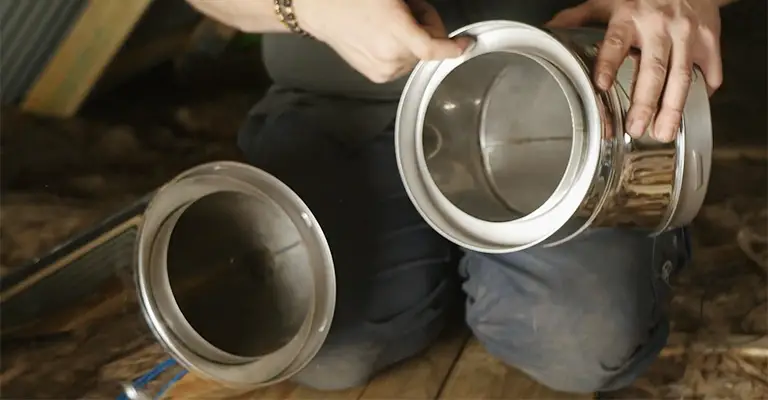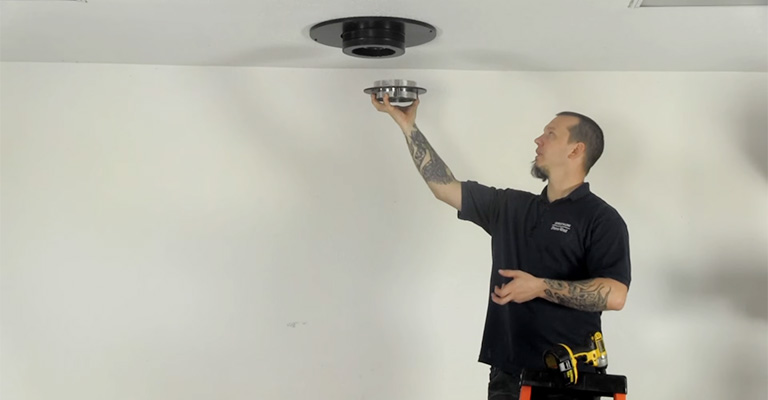Single wall stove pipe is a type of chimney venting system commonly used to ventilate wood-burning stoves and other heating appliances.
Double wall stove pipe, on the other hand, is a type of chimney venting system that provides extra protection and safety to your home by creating an air space between the inner and outer walls.
When connecting single-wall stove pipe to double-wall stove pipe, it’s important to use the right equipment and follow the appropriate steps to ensure a safe and secure connection.
In this article, we’ll guide you through the process of connecting single-wall stove pipe to double-wall stove pipe, covering everything from the necessary tools to the best techniques for making a leak-proof seal.
Can You Connect A Single Wall To A Double Wall Stove Pipe?

A single wall pipe can physically connect to a double wall pipe’s inner pipe. In most cases, this is done in order to pass through the ceiling or roof. It depends on your circumstances whether doing so is safe and legal.
According to applicable codes (and common sense), a single wall pipe needs to be kept away from combustible materials.
See what the requirements are for your local building department. A qualified installer or at least a consultation from a qualified person is recommended if you plan to do it yourself.
For insurance purposes, you’ll have to get the piping recertified by the township inspector using an approved adaptor.
If you don’t, your insurance policy may not cover fire damage. It is also a good idea to check with your insurance company.
How To Connect Single Wall Stove Pipe To Double Wall?

To connect a single wall stove pipe to a double wall stove pipe, you will need the following materials:
- A single wall stove pipe
- A double wall stove pipe
- A single-wall-to-double-wall stove pipe adapter
- High-temperature silicone sealant
- Sheet metal screws
Here are the steps to follow to connect a single wall stove pipe to a double-wall stove pipe:
- Clean the ends of both the single wall stove pipe and the double wall stove pipe to remove any dirt or debris.
- Slip the single wall stove pipe into the adapter. Make sure the end of the single wall stove pipe is flush with the end of the adapter.
- Apply a generous bead of high temperature silicone sealant around the circumference of the end of the adapter.
- Slip the adapter into the double wall stove pipe. Make sure the end of the adapter is flush with the end of the double wall stove pipe.
- Secure the adapter to the double wall stove pipe using sheet metal screws. Make sure the screws are tightly fastened to prevent any leaks.
- Repeat the same process to connect additional pieces of stove pipe, if necessary.
- Check all connections for any leaks before using the stove.
Frequently Asked Questions
Here are some frequently asked questions about connecting single wall stove pipe to double wall stove pipe:
1. Can I use any type of sealant for this connection?
No, it is important to use a high temperature silicone sealant specifically designed for stovepipe connections. Other types of sealants may not be able to withstand the high temperatures generated by a stove or heating appliance.
2. Is it necessary to use a single wall to double wall stove pipe adapter?
Yes, it is necessary to use a single wall to double wall stove pipe adapter to make the connection between the two types of stove pipes.
The adapter serves as a transition piece and provides a secure, leak-proof seal between the single wall stove pipe and the double wall stove pipe.
3. Can I connect a single wall stove pipe directly to a chimney?
No, a single wall stove pipe cannot be connected directly to a chimney. A double wall stove pipe must be used to connect the stove pipe to the chimney, as the double wall provides an extra layer of protection and safety.
4. Can I connect multiple pieces of stove pipe together without using an adapter?
No, it is not recommended to connect multiple pieces of stove pipe without using an adapter. Using an adapter ensures a secure, leak-proof connection and helps prevent any dangerous chimney fires.
5. How often should I check my stove pipe connections for leaks?
It is a good idea to check your stove pipe connections for leaks at least once a year, or more frequently if you notice any signs of damage or wear. Leaks can be dangerous and increase the risk of chimney fires, so it’s important to address them promptly.
Final Words
By following these steps, you can successfully connect a single wall stove pipe to a double wall stove pipe and ensure a safe and secure venting system for your heating appliance.







